Long-Haul Economy Class on an A321: How Bad Could It Be?
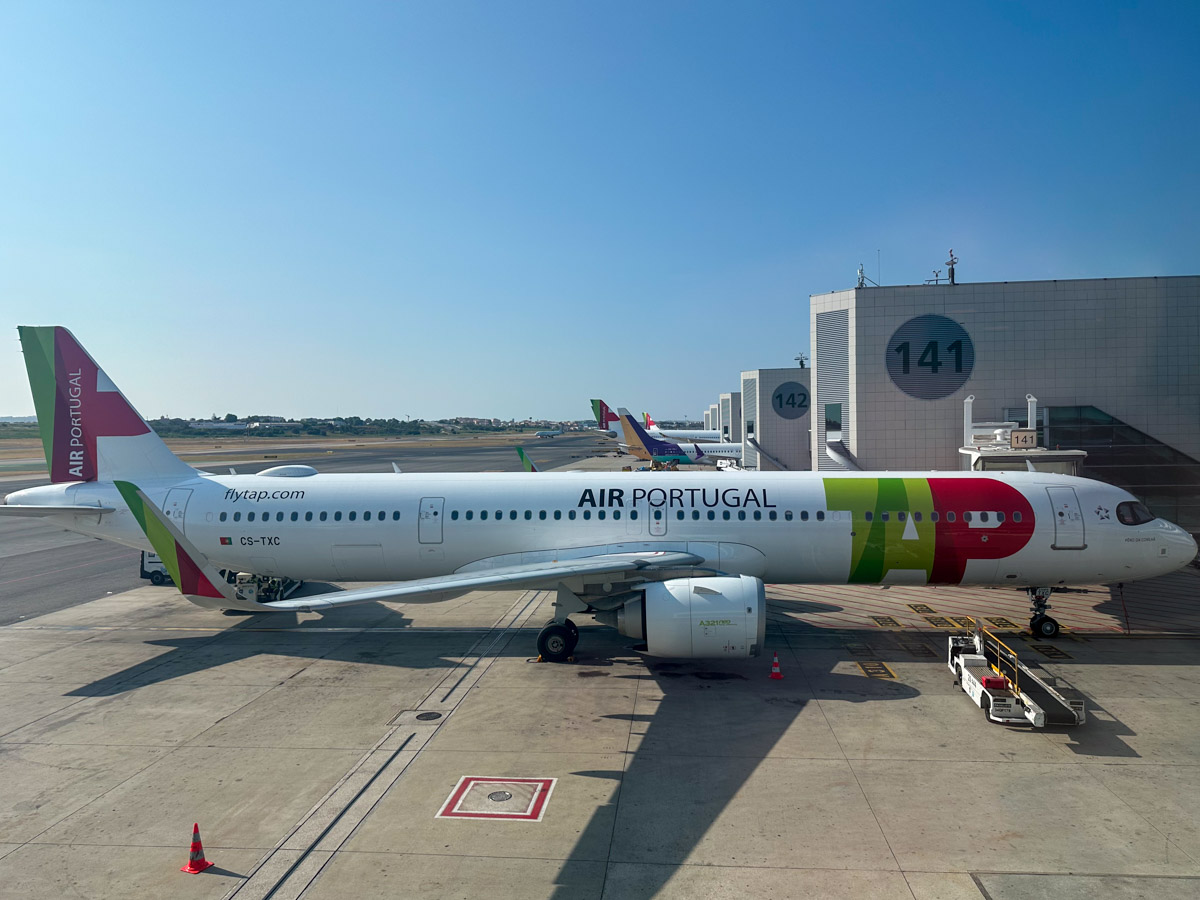
Long-haul trans-Atlantic flights have traditionally been the domain of large, wide-body jets. In fact, it wasn’t that long ago that you’d commonly see Boeing 747s flying many of the routes between Europe and North America.
In the past, smaller jets just didn’t have the range to operate long flights of seven or more hours. But technology has come a long way in recent years.
With a range of around 4,000 nautical miles and great fuel efficiency, the newly introduced Airbus A321neo LR is more than capable of operating trans-Atlantic flights.
In fact, Star Alliance member TAP Air Portugal has an entire sub-fleet of these jets which it uses to fly from Portugal to the USA, Canada and Brazil. JetBlue, Air Transat, Aer Lingus, SAS and Icelandair also now have Airbus A321neo LR jets in regular trans-Atlantic service.
The Airbus A321XLR, which launch customer Iberia put into service on trans-Atlantic routes in November 2024, has an even longer range of 4,700 nautical miles – allowing it to fly for up to 11 hours. (The “XLR” stands for “eXtra Long Range”.)
These extended-range Airbus A321s are now the fastest selling commercial airliners. These jets make it economical for airlines to fly long, thin routes that don’t have enough passengers to justify using a bigger plane. In the future, this could include routes like Adelaide-Singapore and Canberra-Singapore.
Put simply, we can expect to see a lot more medium to long-haul flights on narrow-body jets into the future. But what’s the experience like for passengers flying such long sectors on relatively small, single-aisle planes?
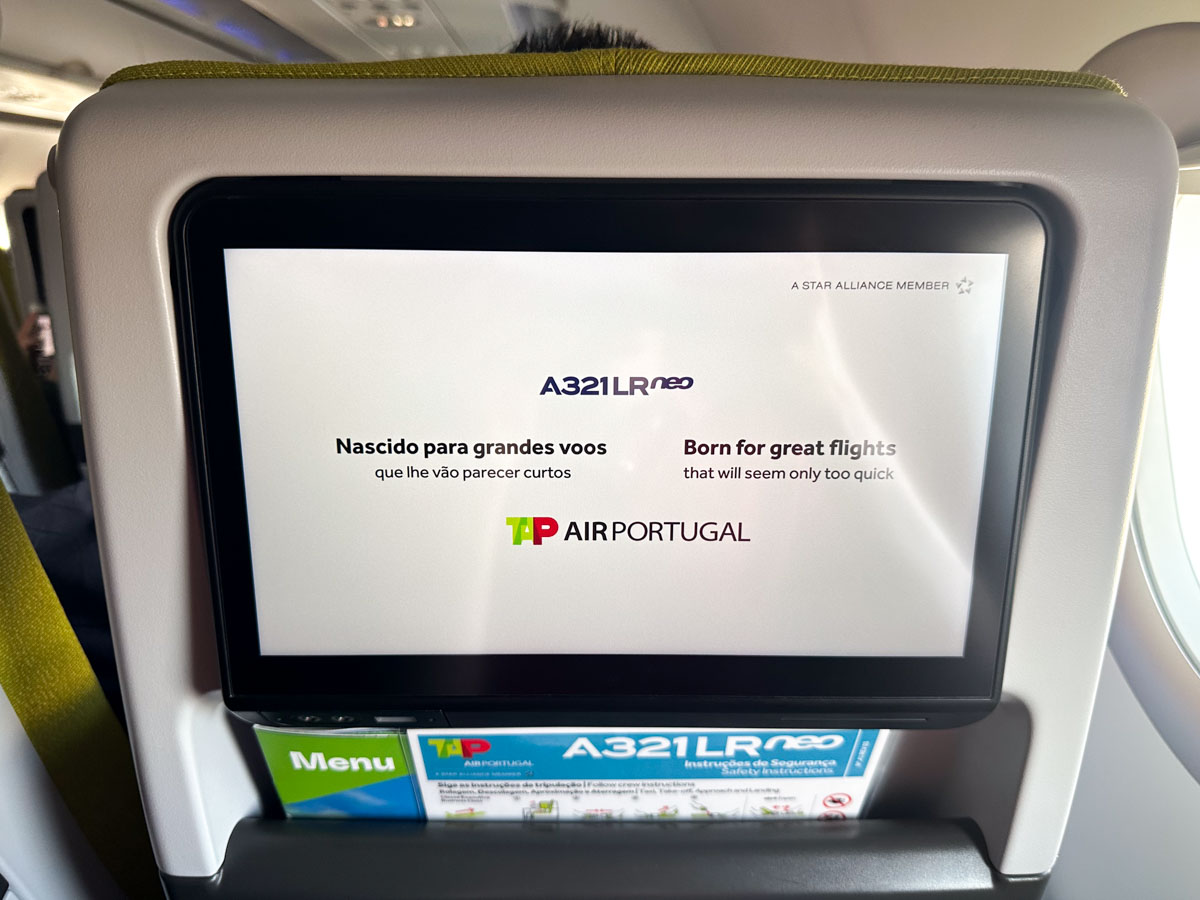
I’ve previously written about the Airbus A321neo LR Business Class experience on TAP Air Portugal, as well as on Air Astana. In this review, I share my recent experience flying TAP Air Portugal Economy Class on the A321neo LR from Lisbon to Montreal.
To be honest, I went into this 7.5-hour flight with low expectations. Just how bad could it really be?
Flight Details
| Flight number | TP253 |
| Route | Lisbon (LIS) to Montreal (YUL) |
| Aircraft type | Airbus A321neo LR |
| Class of travel | Economy |
| Seat number | 31F |
| On-time performance | We arrived 10 minutes late |
| Star rating |
The route
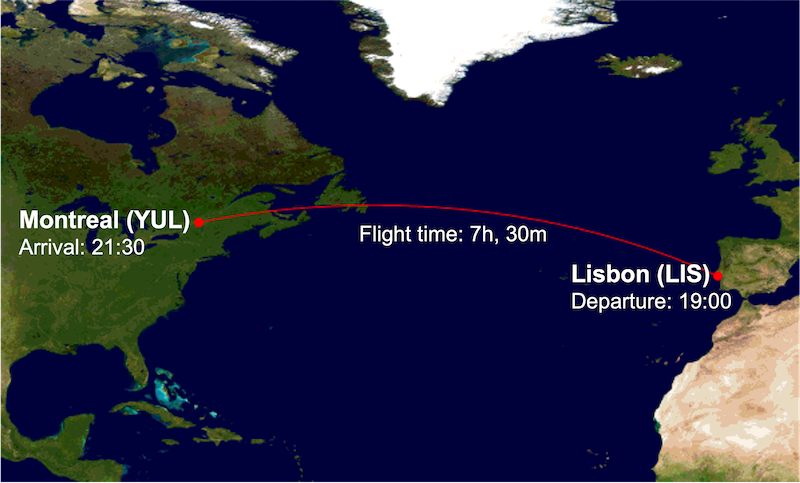
Flight Cost
I took this flight as part of a one-way Economy Basic ticket from Paris to Montreal via Lisbon, for which I paid €352.17. This is a more expensive fare than the “Economy Discount” option and includes a checked bag, but not seat selection.
TAP’s dynamic currency conversion rip-off
At the time of booking, this should have translated to around AUD587. However, when I booked on the TAP Air Portugal website, the airline automatically converted the ticket price from Euros into Australian Dollars, using dynamic currency conversion, after I entered my credit card details.
At no point did TAP inform me that it would convert the amount to another currency using a marked-up exchange rate, nor did I consent to this. As a result of this, TAP ended up charging my credit card AUD605.
When I contacted TAP about this, they repeatedly denied that they had charged me in Australian Dollars at all – even though I had clear evidence that they had and my bank even confirmed this. I felt that this was tantamount to a scam, so I actually ended up disputing this transaction with my Australian bank. Through the chargeback process, I eventually got a refund for the difference between what I should have paid and what TAP actually charged my credit card.
For future reference, you can choose which currency you pay in by using the PayPal payment option on TAP Air Portugal website.
Airport Experience
I had checked in for this flight earlier in the day in Paris, where I’d received boarding passes and my bag was checked all the way through to Montreal.
After arriving in Lisbon, I simply had to pass through immigration and head to the next gate. Lisbon Airport was busy, as it often is, but this was a fairly seamless process.
There was an extra security check to enter the boarding gate area, and boarding eventually started around 35 minutes after the time printed on my boarding pass. Premium boarding for Business Class, Star Alliance Gold and passengers with young children was called first.
Lounge access at Lisbon Airport
As lounge access isn’t a standard TAP Economy Class inclusion, this has no bearing on my rating for this review. But for those who have status or might be considering purchasing lounge access, I’ll talk briefly about this now.
There are a few shops and restaurants in the non-Schengen departure area at Lisbon Airport, but the only lounge after immigration is the new TAP Premium Lounge Atlântico. (You could alternatively use Priority Pass to access the ANA Lounge, which is before immigration.)
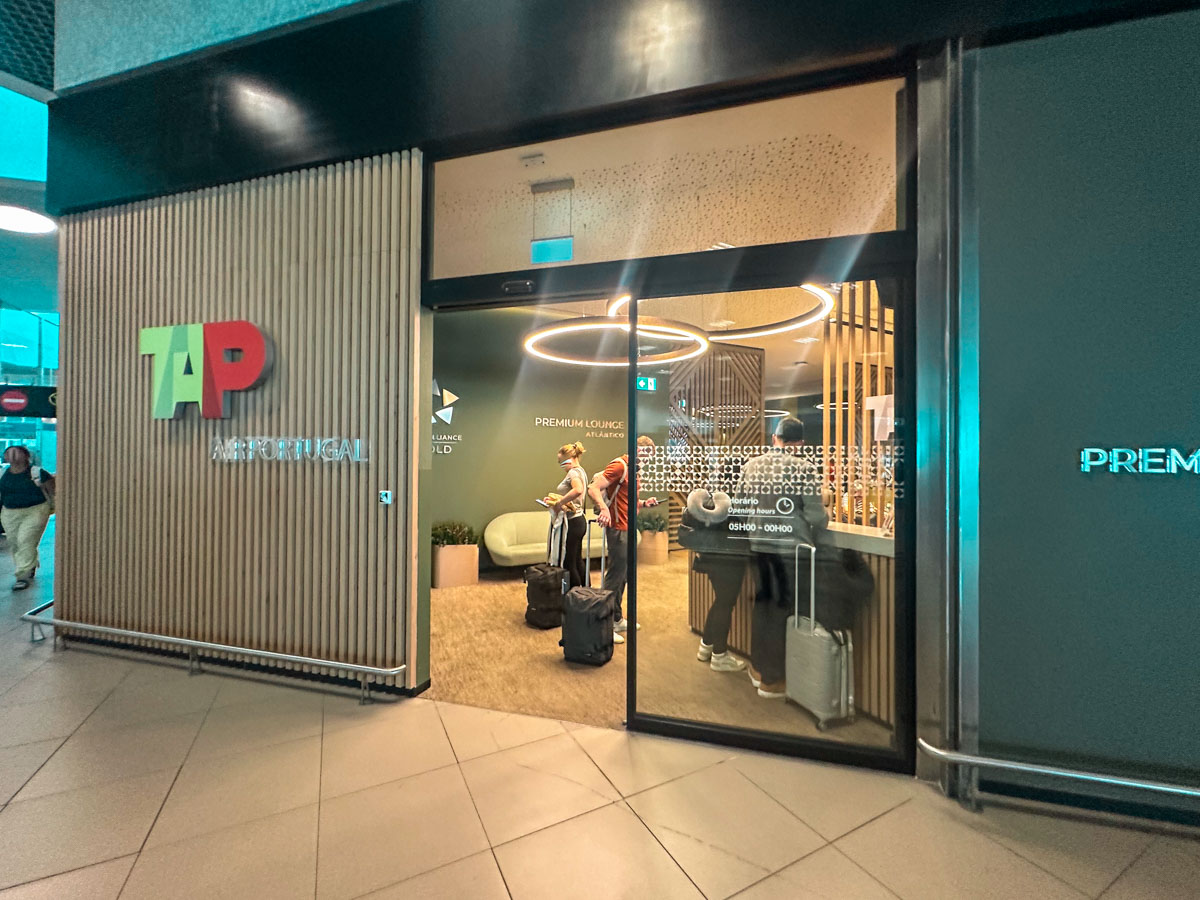
I was able to access this lounge as a Star Alliance Gold frequent flyer. But even without status or a TAP Business Class ticket, you could buy access to the lounge during online check-in. (For some reason, TAP tried to sell this to me even though it knew I had Star Alliance Gold status.)
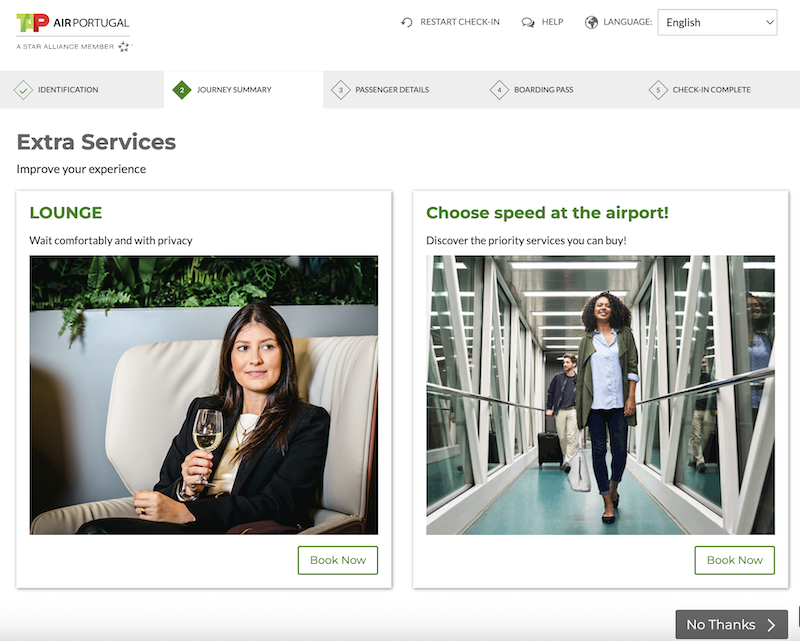
This lounge is considerably smaller than TAP’s lounge in the Schengen section of Lisbon Airport, and lacks natural light. But it did have enough seating to cope with the number of passengers, and it had toilets, Wi-Fi, a reasonable buffet and a good selection of drinks.

I found the range of beer, wine and spirits particularly impressive, and liked the instructions for DIY cocktails.
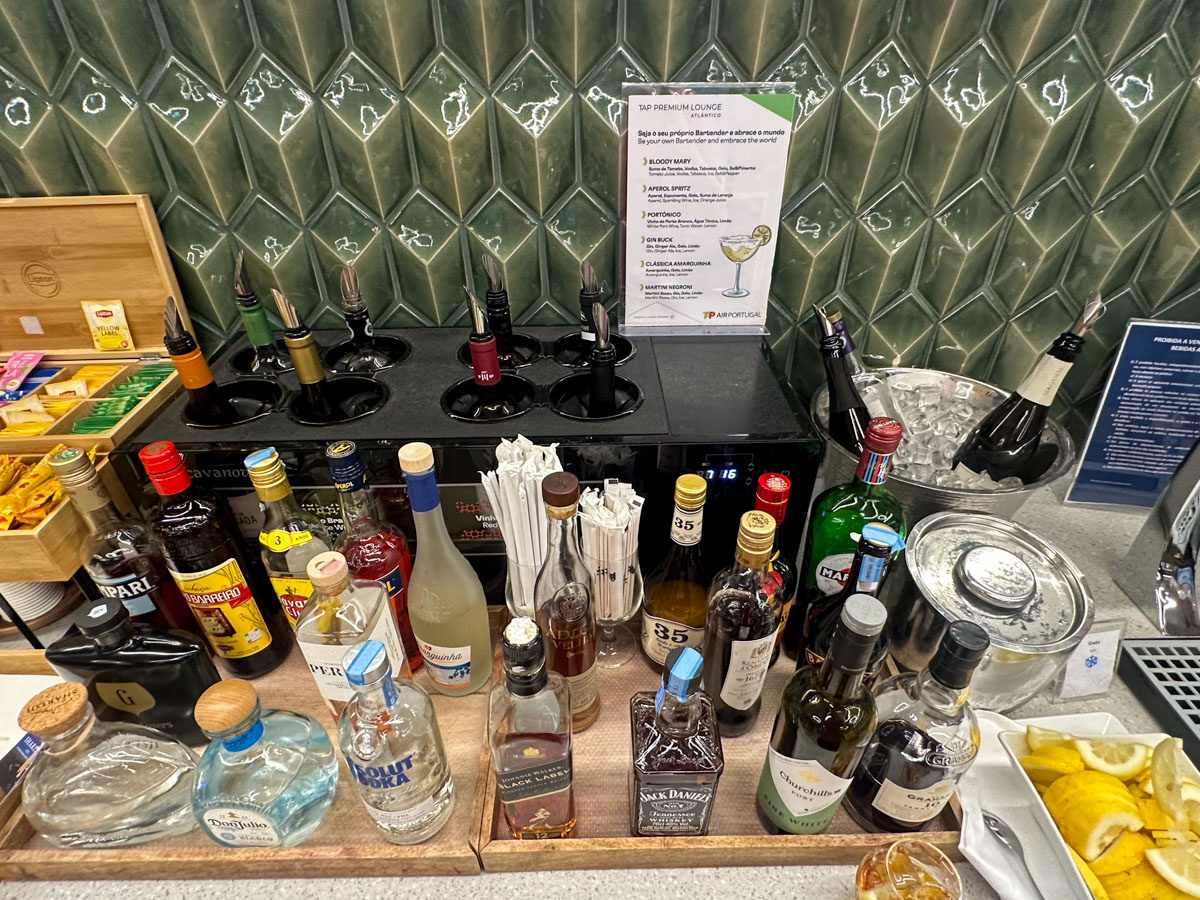
TAP Business Class upgrade offer
For what it’s worth, TAP also offered a Business Class upgrade when I checked in online for €600 (~AU$1,062 at the current exchange rate), which I declined.
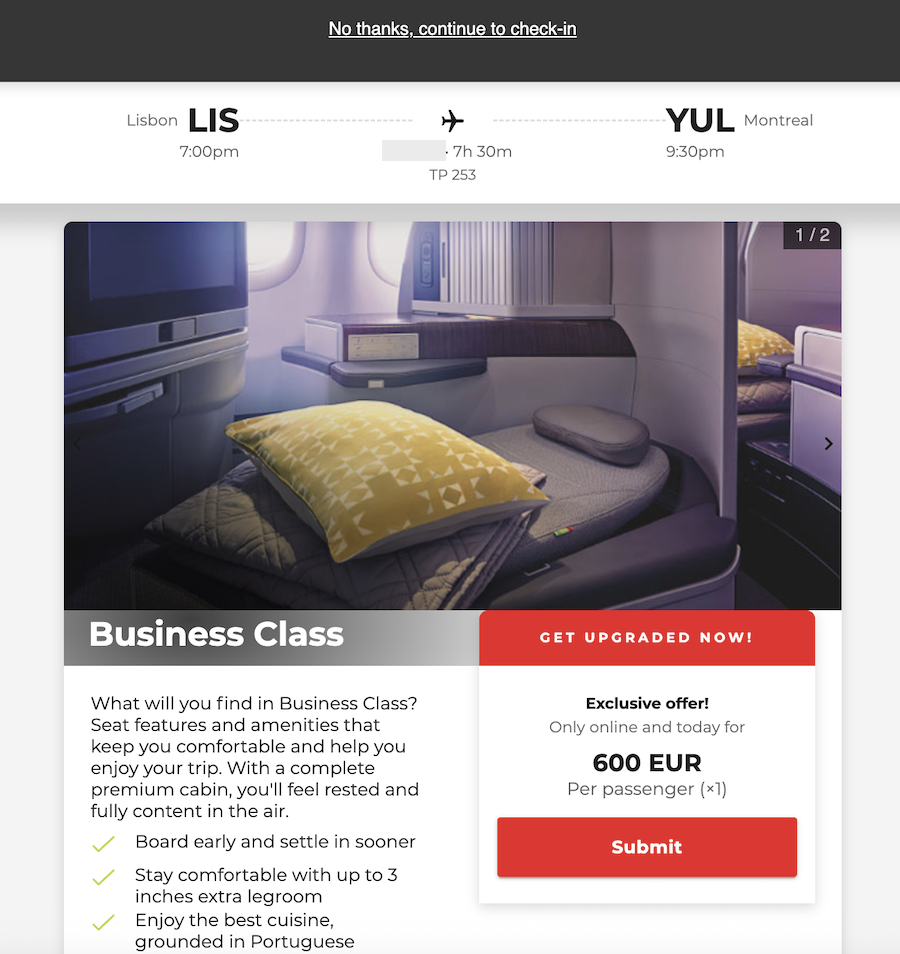
The Hard Product
Although TAP offers a no-frills Economy Class on its regular Airbus A320s, its Airbus A321neo LRs are specifically designed for long-haul flying. So, the seats are a bit more comfortable and have in-flight entertainment screens built in.
The plane itself was quite nice, with pleasant mood lighting and large overhead bins. Overall, the interior appeared modern, clean and well-maintained.
TAP A321neo LR Economy Class seats
Economy Class is laid out in a standard 3-3 configuration.
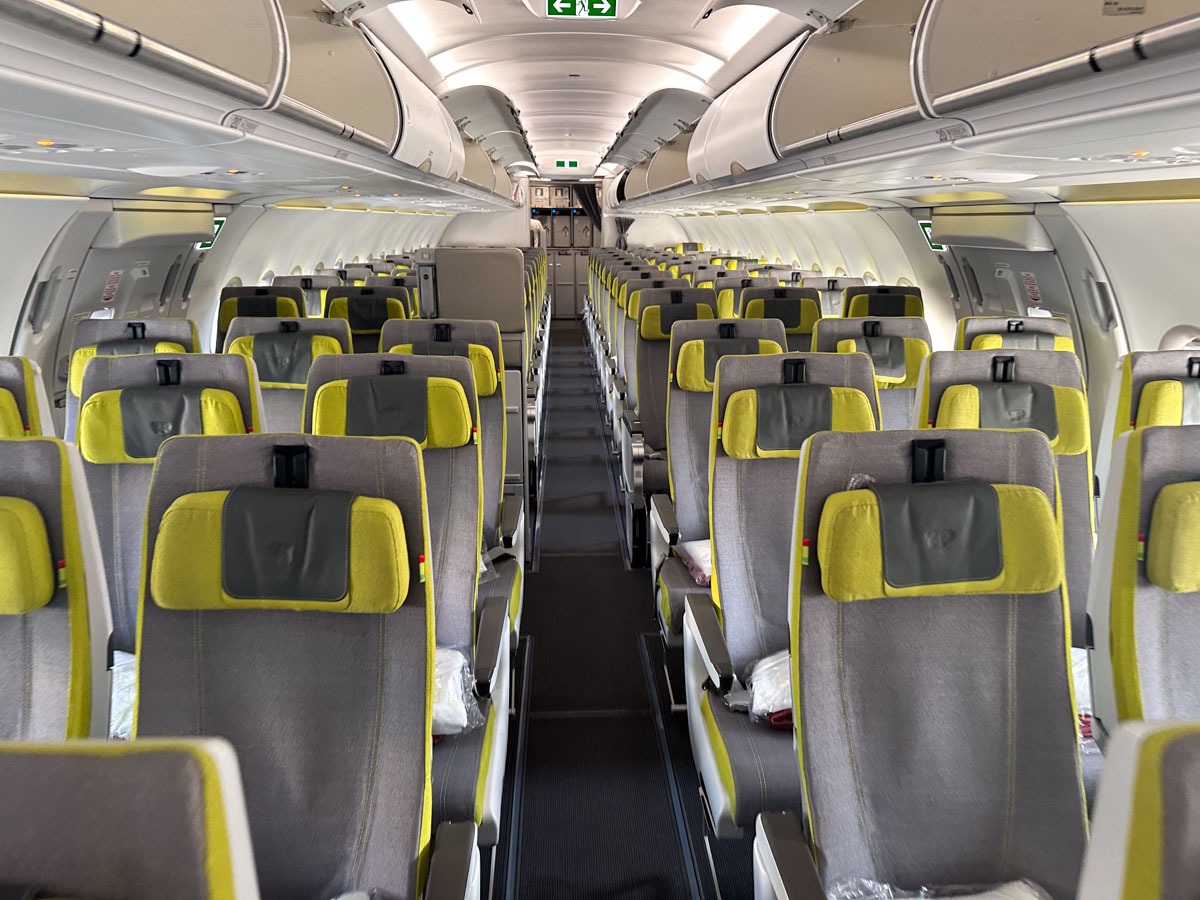
The seats are covered in cloth and have an adjustable headrest. I found my seat surprisingly comfortable and well-padded, even after sitting in it for almost eight hours.
On this particular flight, I had been allocated a window seat in the very last row:
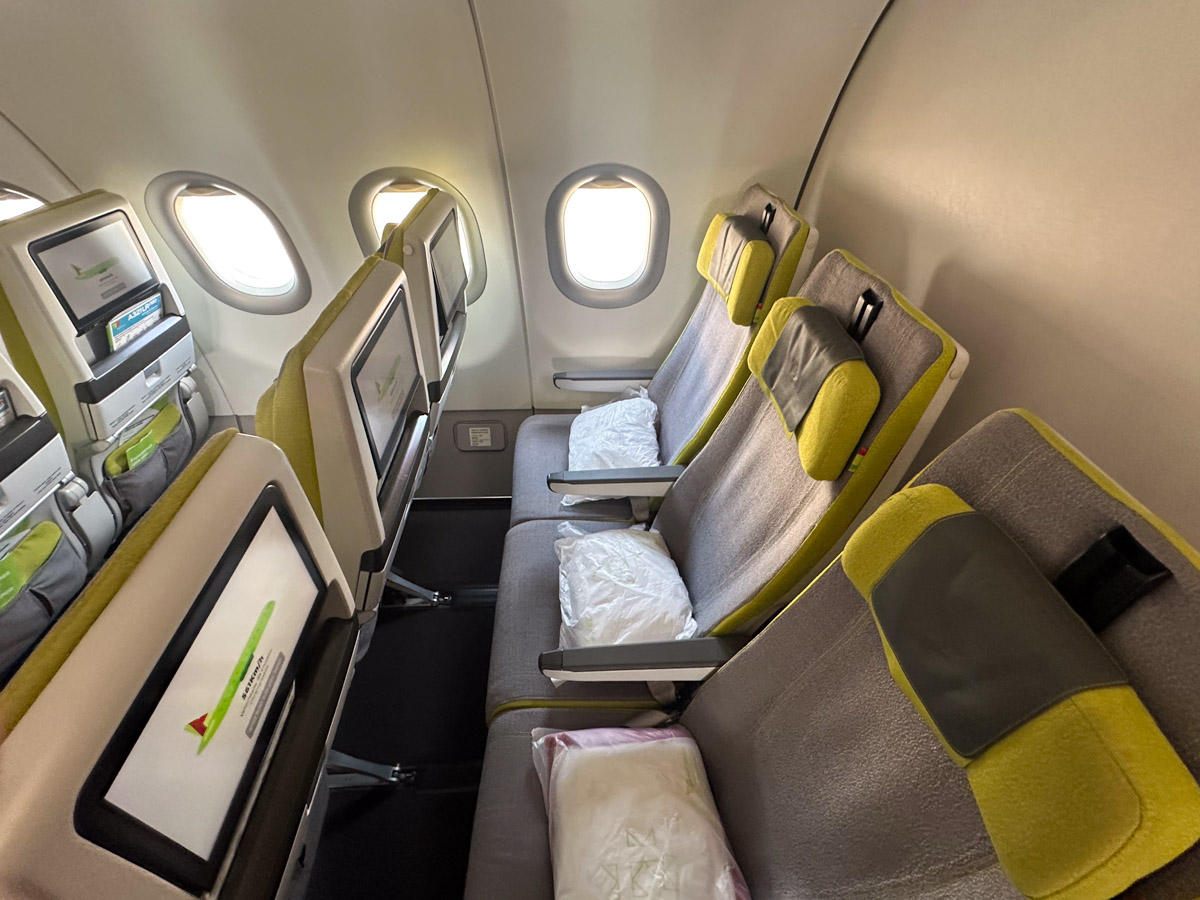
I was initially a bit worried that this would be a terrible seat, as it was right in front of the toilets and AeroLOPA indicated that it might be a bit narrower than other seats. But I didn’t feel it was worth paying the €51 (~AU$90) that TAP wanted to charge me to choose another seat, so stuck with it.

In the end, I was actually quite happy with seat 31F. It wasn’t any narrower than in other rows – in fact, being an Airbus A320 family aircraft, the seat was reasonably wide. I also enjoyed the guilt-free recline that comes with sitting in front of a wall, and it probably helped that my two seat neighbours on this completely full flight were lovely.
The legroom was quite reasonable, and there was a power outlet under the seat. The seat pocket was well designed with several different compartments.

In-flight entertainment and Wi-Fi
There was a large, high-definition in-flight entertainment screen on the back of the seat in front. This had a wide selection of movies, TV shows, music and games to choose from. It also offered a comprehensive moving map, and you could use it to view the on-board menu.
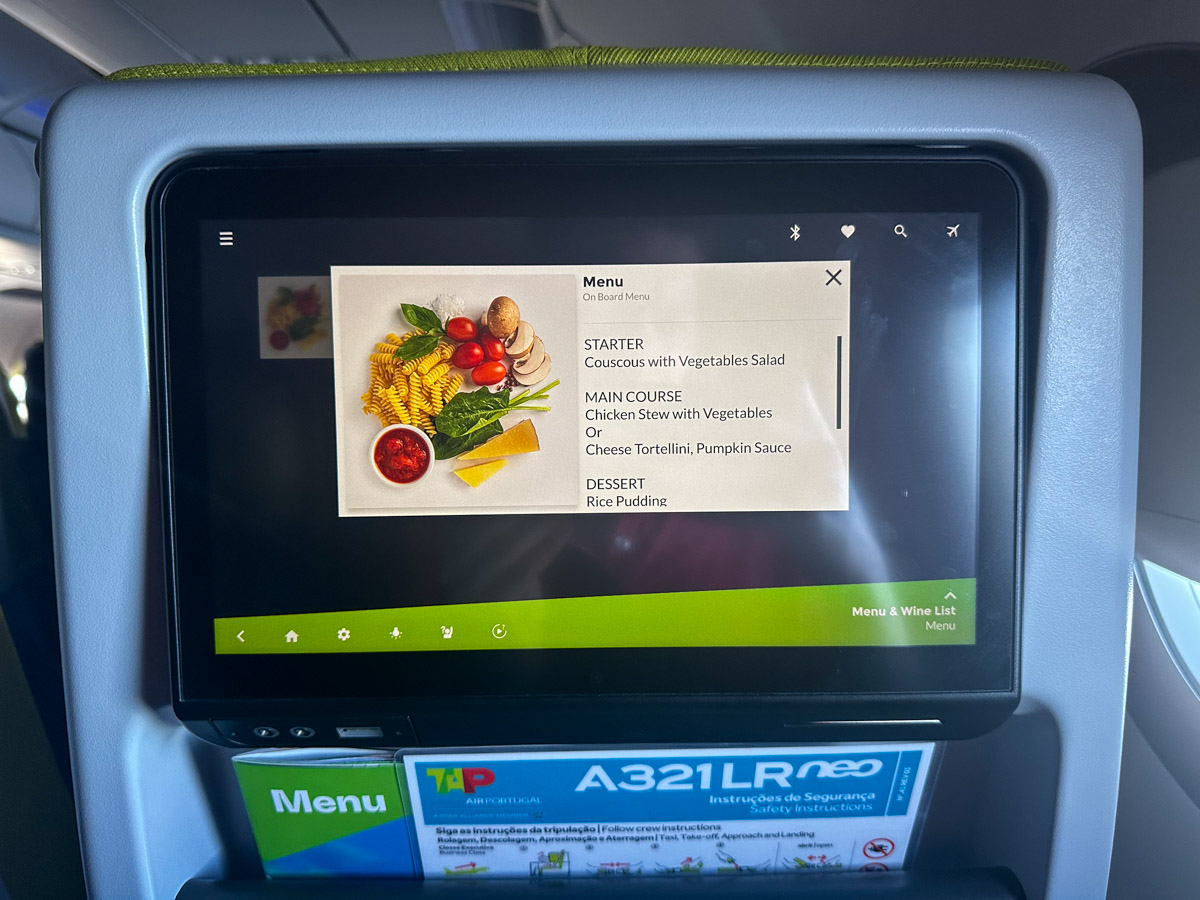
TAP offers Wi-Fi for a fee on its long-haul Airbus A321neo LR and A330neo planes. Even if you don’t pay for a package, you can get free messaging during the flight.

The Soft Product
We took off a few minutes behind schedule and started heading west across the Atlantic Ocean.
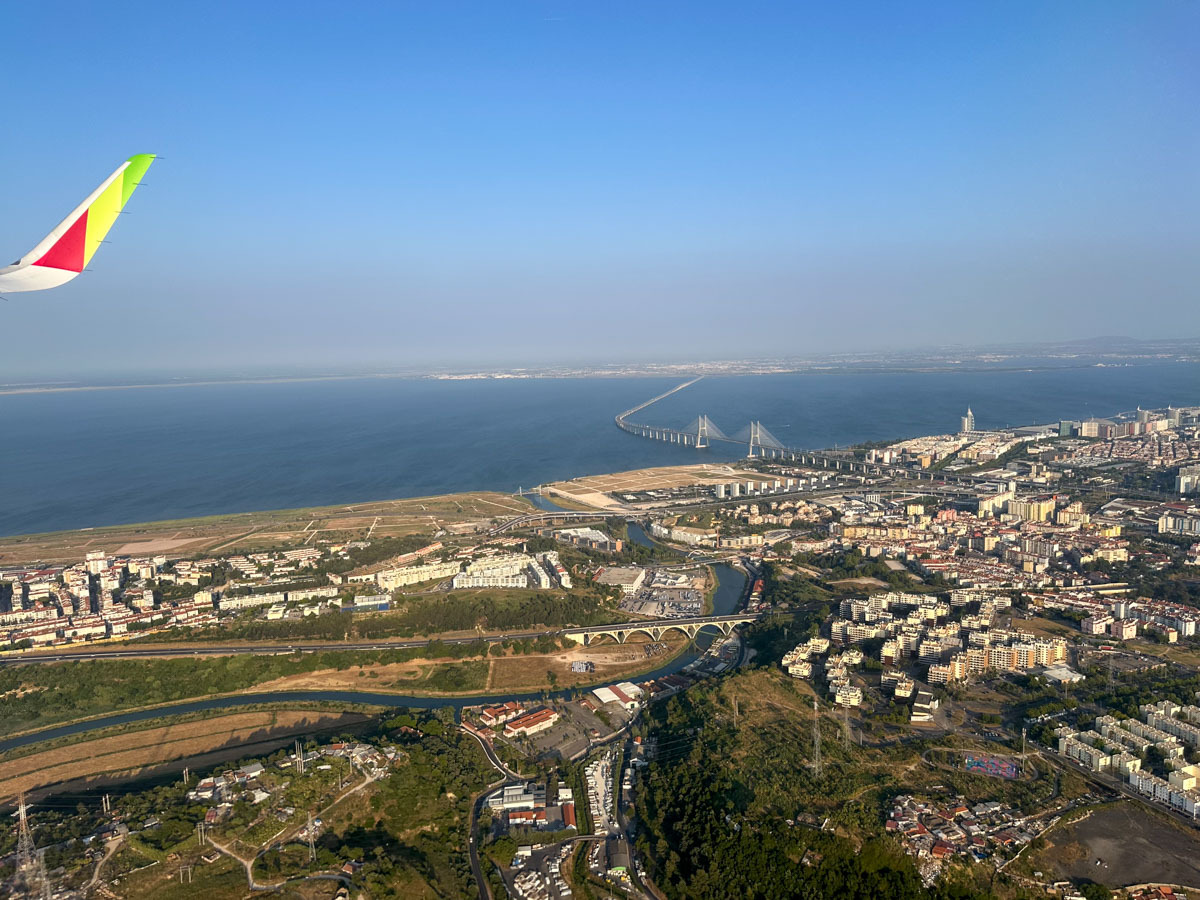
There was a pillow and blanket on every seat when I boarded the plane.
After take-off, the cabin crew also distributed basic headphones (and some small chocolates to get the meal service started). The headphones were quite poor quality, so I’d recommend bringing your own noise-cancelling headphones if you can.
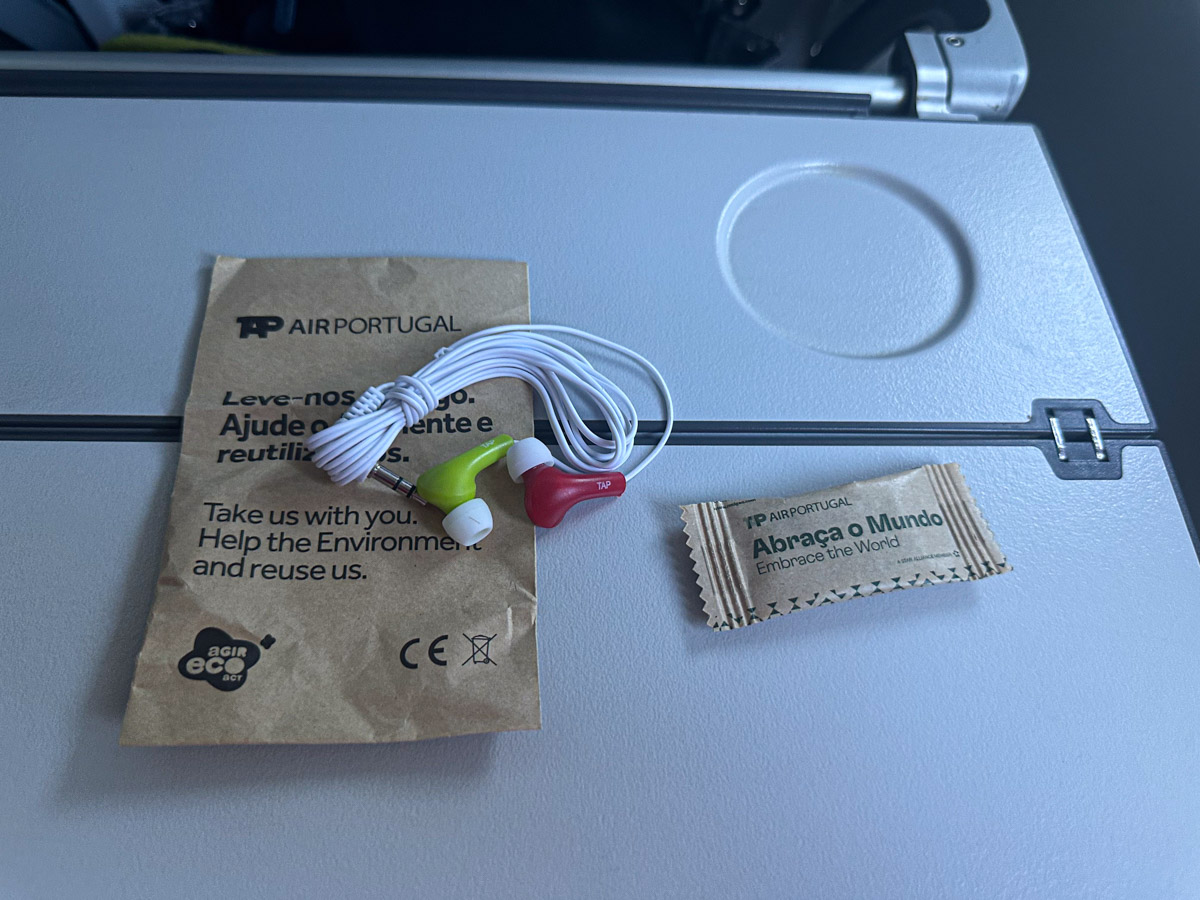
Shortly after this, the crew started the dinner service. Although there was a printed menu in the seat pocket with prices, the two meals on this flight were complimentary. (In fact, I don’t think any of those additional snacks from that menu were actually available for sale – I suspect the menu was just left there as the same plane sometimes does short-haul flights.)
There were theoretically two hot meal choices for dinner, but they ran out of chicken well before reaching my row. So, I was left with the pasta. This came with various accompaniments including a couscous salad, rice pudding, bread roll and crackers with some kind of cheese spread.

A range of complimentary drinks was also available with the meal including beer, wine, cola, juice and water. The crew did not proactively offer any drink top-ups, although tea and coffee were on the trolley when they cleared the meal trays.
I’m sorry to say that I found the cheese tortellini incredibly bland and disappointing. It lacked any real flavour or nutritional value, and just seemed like something that was cheap to produce at scale. (Even more so than airplane food normally is…)
On the plus side, the meal came with proper metal cutlery.
After dinner, the crew dimmed the cabin lights and asked everyone to close their window shades. I was a bit disappointed as we were flying into a very long sunset and I was enjoying the view.
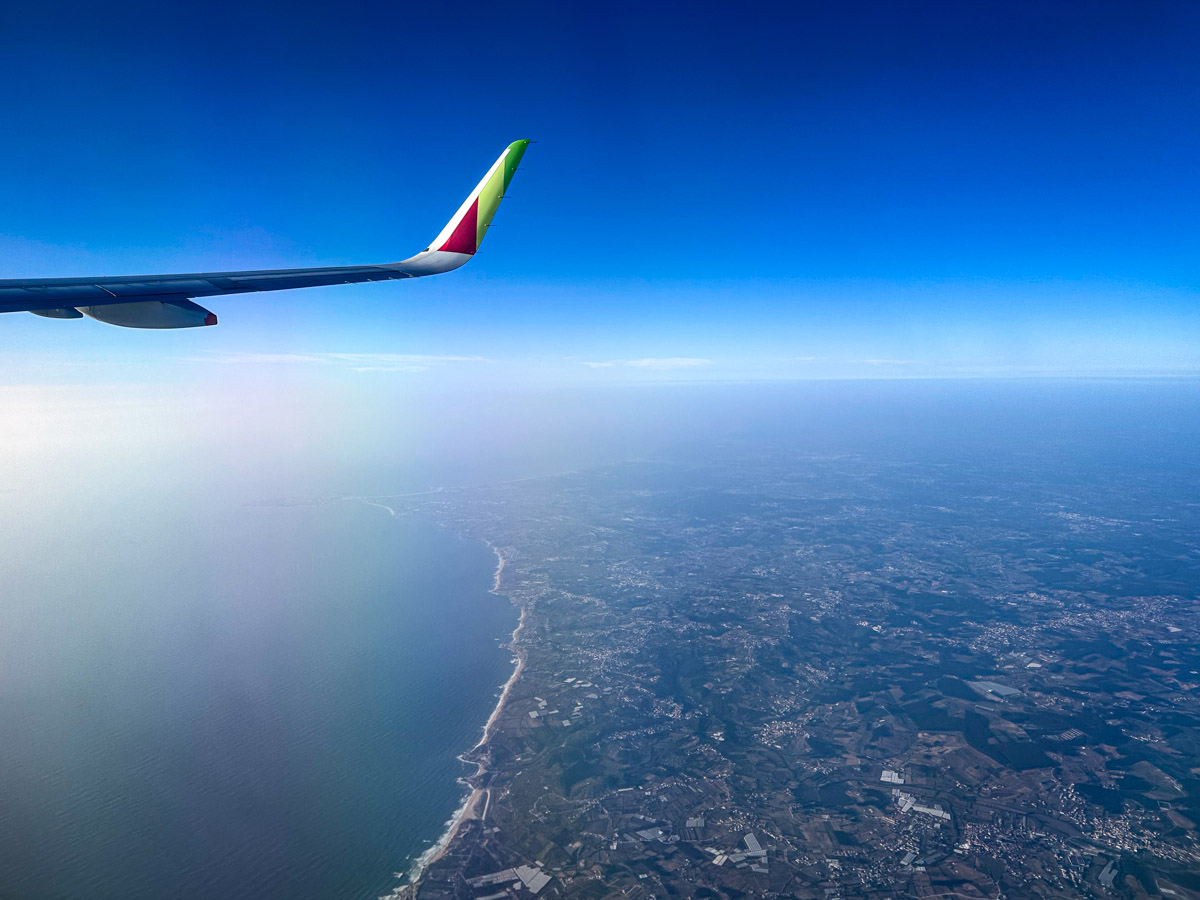
Other than two water runs, I barely saw any of the three cabin crew members looking after Economy again until they served a pre-arrival snack around an hour before landing (and one time when they came through the cabin checking seatbelts during turbulence).
That snack was a ham sandwich served on rather dry bread. This came with a brownie and drinks – although there were no alcoholic drinks loaded onto the trolley this time around.
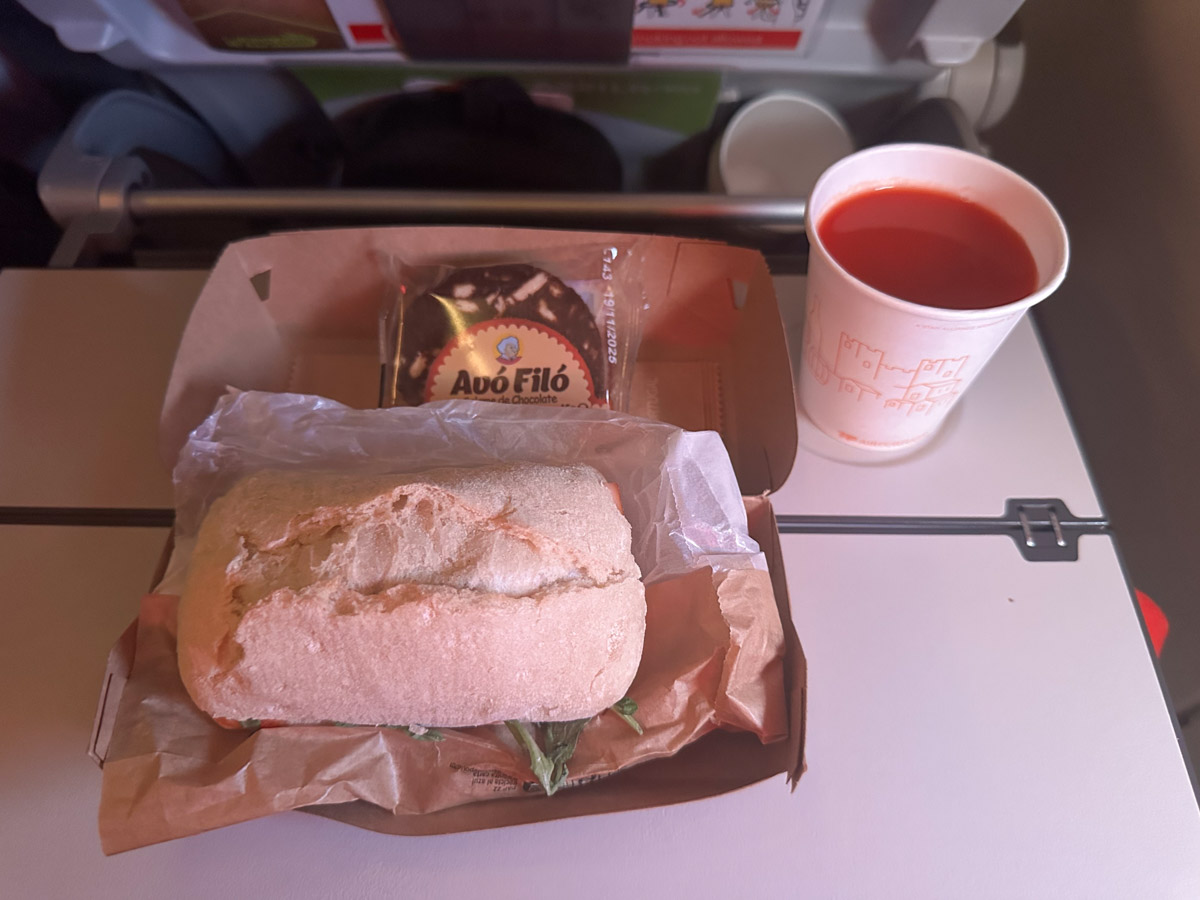
The cabin crew did their jobs just fine, but to be honest, they seemed a bit like they were just going through the motions. I wouldn’t say they oozed enthusiasm or went particularly above and beyond.
My verdict: Flying 7+ hours on an Airbus A321neo LR
I had low expectations for this flight and I’m pleased to say that it wasn’t as bad as I expected.
I think that part of this comes down to the fact that TAP has especially configured its Airbus A321neo LR for long-haul operations. It actually has reasonably comfortable seats with better legroom than TAP’s standard A320s, as well as in-flight entertainment screens at every seat. This isn’t the same as Virgin Australia using a Boeing 737 designed for short domestic hops to fly to Tokyo.
But is the nicer interior just lipstick on a pig, or is this actually a great way to fly for more than seven hours? Well, in my opinion, it’s a bit of both.
A thoughtful cabin layout is essential
The fairly nice cabin interior definitely helped make this flight more enjoyable. And it’s definitely a good thing that TAP installed an extra toilet at the front of the Economy cabin, in addition to two at the back. This helped to minimise one of the most obvious problems associated with narrow-body planes – being unable to access a toilet when there’s a trolley in the aisle.
TAP also has proper lie-flat Business Class seats on these planes, making them a lot more competitive among premium travellers.
Without these kinds of features, I can’t imagine that flying a narrow-body plane for this amount of time would be an enjoyable experience at all.
Qantas will start receiving its own Airbus A321XLRs next month. These could technically fly from the Australian east coast to Asia, but Qantas is configuring them for domestic operations with reclining Business Class seats and without seat-back entertainment screens. I don’t think this would be a competitive offering for Qantas on routes over 5-6 hours.
Meanwhile, Jetstar has configured its Airbus A321neo LRs with a very dense Economy Class layout. The seats are thin and uncomfortable, and there isn’t much in the way of onboard amenities. This isn’t a great on-board experience on a route like Rarotonga-Sydney which is over seven hours, but Jetstar is primarily competing on price.
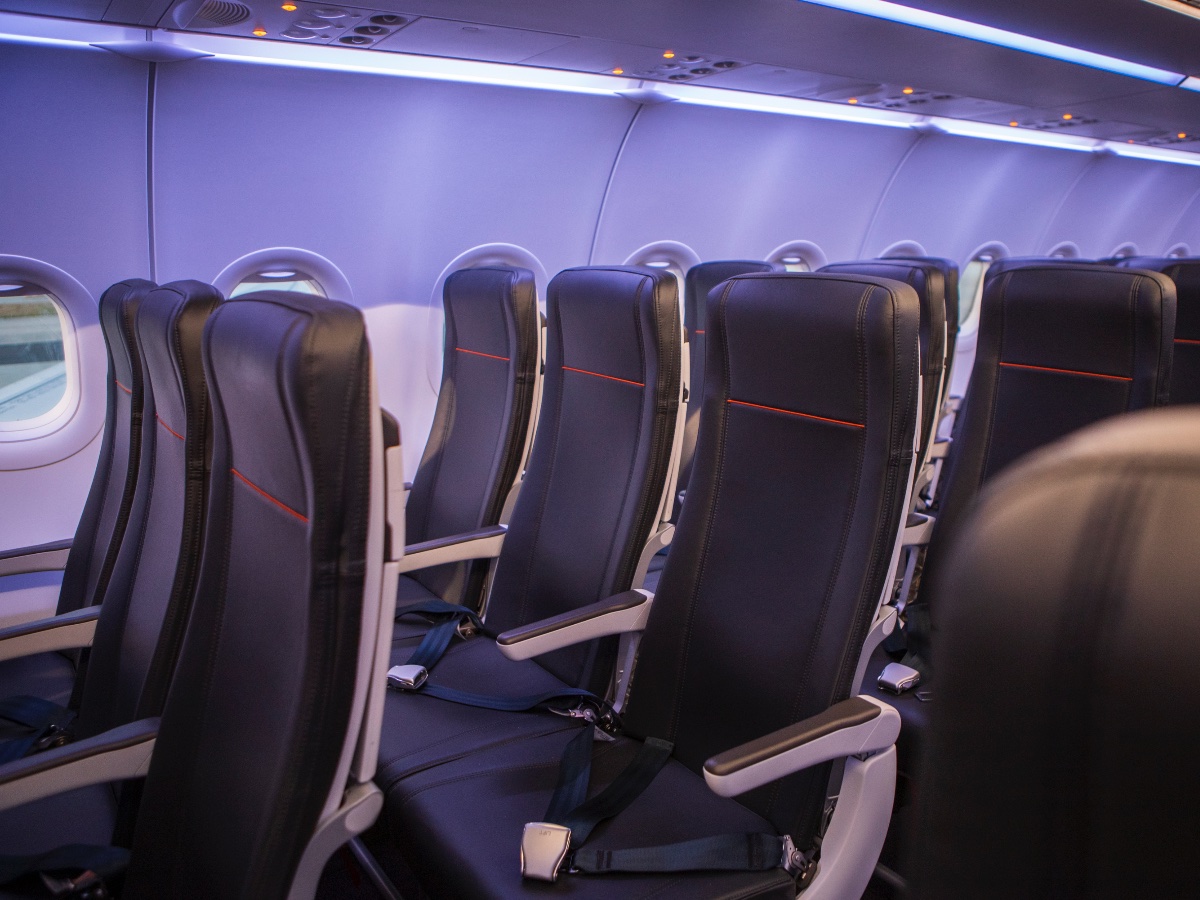
The downsides of flying on a narrow-body plane
Given the choice, I would still prefer to fly on a wide-body jet across the Atlantic in Economy Class. Even if the airline puts thought and care into the cabin layout, there’s no denying that flying on a narrow-body plane is less comfortable… and frankly, less fun.
For starters, there are only two aisle seats per row, instead of four on a wide-body. I consider aisle access to be a lot more important on longer flights, and the simple fact is that narrow-bodies have a lower percentage of aisle seats. There’s also far less chance that you’ll have exclusive aisle access, which you can sometimes enjoy if you get an aisle seat in the middle block on a wide-body. That means your sleep is more likely to be interrupted on an overnight flight.
Secondly, there are fewer overhead lockers on narrow-body planes. (This was made worse on this particular flight by the fact that life rafts and crew bags were taking up all the space above the last two rows.)
Thirdly, there isn’t really anywhere to stand up and stretch your legs on an Airbus A321. The only real options are to stand in the aisle or in the rear galley, where space is limited and the cabin crew are trying to work. On a larger plane, you can usually stretch a bit near the toilets, around the galleys or near the exit doors.
Finally, I did think that the turbulence was more pronounced when flying on a smaller plane. Before this flight, I noticed that Turbli was predicting we’d hit moderate turbulence between 2.5-4 hours into the flight. We did, and we certainly felt it. This might just be my imagination, but I don’t think it would have felt as uncomfortable on a larger jet.
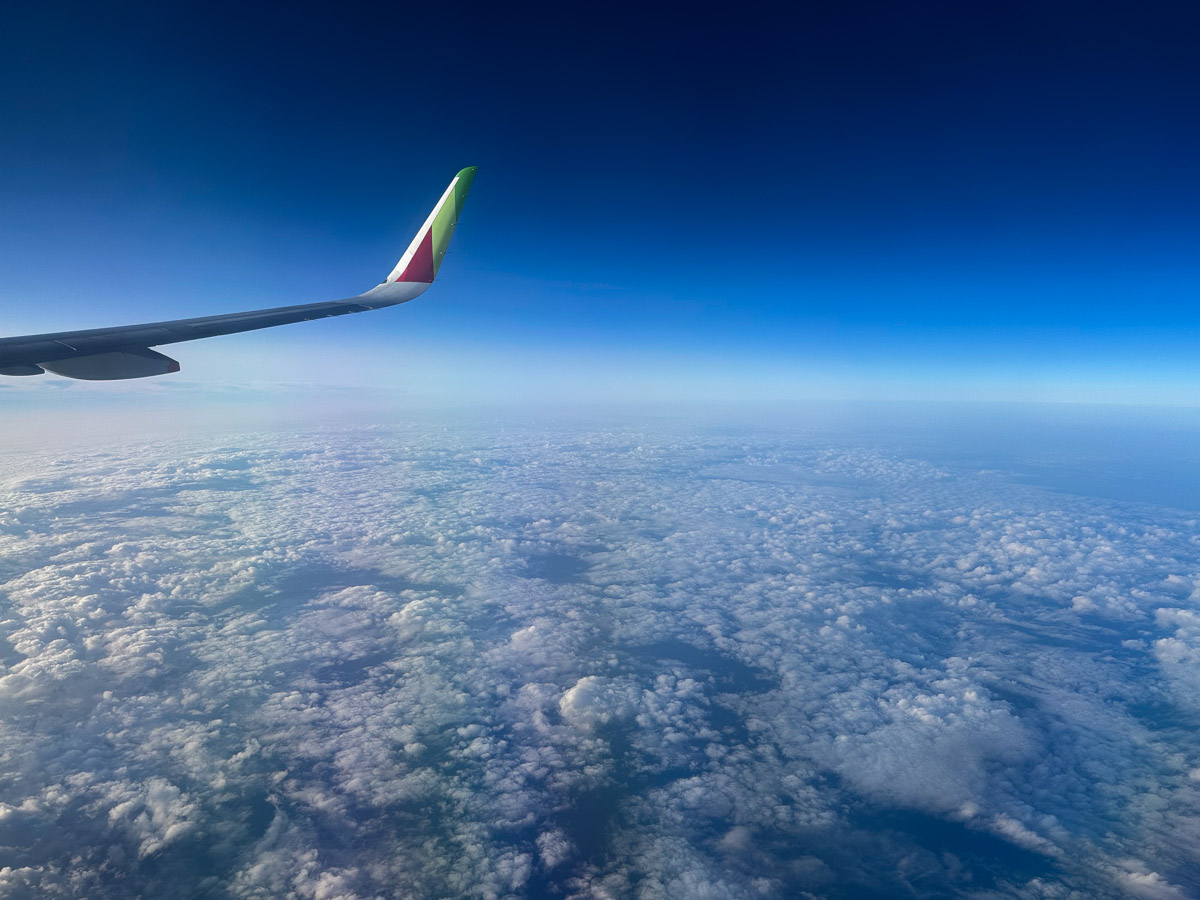
TAP Air Portugal A321neo LR Economy Class
-
Airport Experience
-
Hard Product
-
Soft Product
Final thoughts
Overall, my first trans-Atlantic flight on a narrow-body jet was better than I expected. But my expectations were low.
I probably wouldn’t actively choose this over a wide-body jet. Nonetheless, the Airbus A321neo LR is a very capable and modern plane that does the job. And the reality is, this plane opens up more marginal routes that might not otherwise exist – as well as allowing airlines to add more frequencies. This is also good for competition.
While the on-board service was fine, I consider TAP Air Portugal to be somewhat of a glorified low-cost carrier. The airline’s trans-Atlantic fares do at least include meals and entertainment, but the food was a bit of a letdown. And charging ~AU$90 just to choose a regular seat, when I didn’t even book the cheapest fare category, seems a bit over the top.
You can leave a comment on the Australian Frequent Flyer forum.



Community Comments
Loading new replies...
Join the full discussion at the Australian Frequent Flyer →